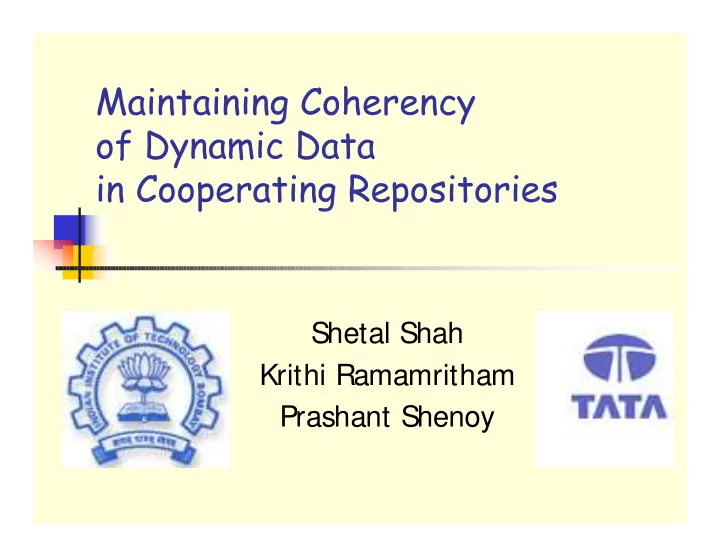

Shetal Shah Krithi Ramamritham Prashant Shenoy
rapid and unpredictable changes stock prices, sensor data used in on-line decision making ideal world: every change delivered to every user. coherency requirement (c): E.g. Infosys stock price changes by $ 5 Source Repository Client P(t ) S(t) U(t) − < U ( t ) S ( t ) c
Design a dissemination system for dynamic data -- meet users’ coherence requirements -- minimize fidelity loss Metric: length of time for which coherency req is met Fidelity = total length of observations Dissemination systems for the web include Akamai, Dynamai
Source(s), repositories (and clients) Each repository specifies its coherency requirement Source pushes specific changes to selected repositories Repositories cooperate with each other the source
Data Set: p,q,r,s Source degree of cooperation: 2 A B p:0.2, q:0.3 r:0.2 D C q: 0.3 p:0.4, r: 0.3 Client q: 0.4
When should a repository 1. disseminate updates ? – data dissemination problem What should be the logical 2. interconnection between repositories? – layout problem How much should a 3. repository cooperate? – cooperation problem
Different users have different coherency req Source for the same data item. A B Coherency requirement at p:0.2, q:0.3 r:0.2 a repository should be at D C least as stringent as that p:0.4, r: 0.3 q: 0.3 of the dependents. Client Repositories disseminate q: 0.4 only changes of interest.
P Q 0 . 3 c c 0 . 5 Source Repository P Repository Q 1 1 1 1 1 1.2 1 1.4 1.4 1 1.4 1.5 1.7 1.7 1.7 should prevent missed updates!
Source Based (Centralized) Repository Based (Distributed)
For each data item, source maintains unique coherency requirements of repositories the last update sent for that coherency For every change, source finds the maximum coherency for which it must be disseminated tags the change with that coherency disseminates (changed data, tag)
P Q c 0 . 3 c 0 . 5 Source Repository P Repository Q 1 1 1 1 1 1.2 1 1.4 1.4 1.5 1.5 1.5 1.7 1.5 1.5
A repository P sends changes of interest to the dependent Q if P Q Q
P Q 0 . 3 c c 0 . 5 Source Repository P Repository Q 1 1 1 1 1 1.2 1 1.4 1.4 1 1.4 1.5 1.7 1.7 1.7 should prevent missed updates!
A repository P sends changes of interest to the dependent Q if P Q Q P
P Q c 0 . 3 c 0 . 5 Source Repository P Repository Q 1 1 1 1 1 1.2 1.4 1.4 1.4 1.4 1.4 1.5 1.7 1.7 1.7
When should a repository 1. disseminate updates ? – data dissemination problem What should be the logical 2. interconnection between repositories? – layout problem How much should a 3. repository cooperate? - cooperation problem.
Fidelity offered by the layout network depends upon Maximum end-to-end delay for disseminating updates. Overhead (load) of disseminating updates at each repository. To achieve high fidelity, these delays should be minimized.
Insert repositories one by one Check level by level starting from the source Each level has a load controller. The load controller tries to find data providers for the new repository(Q).
Repositories with low preference factor are considered as potential data providers. The most preferred repository with a needed data item is made the provider of that data item. The most preferred repository is made to provide the remaining data items.
Resource Availability factor : Can repository (P) be the provider for one more dependent? Data Availability Factor : # data items that P can provide for the new repository Q. Computational delay factor : # dependents P provides for. Communication delay factor: network delay between the 2 repositories. ( , ) delay P Q # data items P can serve Q
Single source, 100 repositories. Real time traces of various stocks 50-100 data items. Link delay : Computed by a heavy tailed function. Average link delay: 20-30 ms. Computation delay : 12.5 ms/client Rate of change of data-item: 1 change/sec
Dissemination algorithms Number of checks at source Number of messages. Layout algorithm Loss in fidelity For different coherency requirements For different degrees of cooperation
Repository based algorithm requires fewer checks at source
Source based algorithm requires less messages
T% of the data items have stringent coherency requirements Loss in fidelity % The less stringent the coherency requirement, Degree of cooperation the better the fidelity
Loss in fidelity % too little /no cooperation => loss of fidelity is high Degree of cooperation
can hurt Under high degree of cooperation, computational delays dominate. Loss in fidelity % Under low degree of cooperation, network delays dominate. Degree of cooperation Degree of cooperation
When should a repository 1. disseminate updates ? – data dissemination problem What should be the logical 2. interconnection between repositories? – layout problem How much should a 3. repository cooperate? - cooperation problem.
Actual of cooperatio n degree average network delay = × # average comp delay dependents interested
Max degree of cooperation Degree of cooperation Degree of cooperation Without controlled With controlled cooperation cooperation
Cooperation is essential -- to achieve high fidelity But, need to control the cooperation offered -- when delays are non-negligible Selective Peer to Peer Dissemination of Streaming Data!
Recommend
More recommend